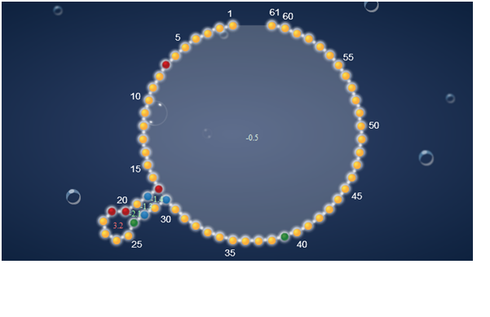lroppy coined the term “boost points” a while ago (a red or green nucleotide put in a loop that lowers the energy of a loop), but since then, thanks to Brourd’s insightful puzzles, we have become aware of another way to use nucleotides in the loops.
A “catalyst point” is a U or C that doesn’t seem to lower the energy of a loop in the way a boost point would, yet when placed in a loop, helps solve the puzzle.
Here’s how it works. Sometimes you have a loop that’s too big because a bond is not bonding that should be. Here is an attempt at a solution for the puzzle “Simple Single Bond”:

But, this does not solve the puzzle. Here it is in natural mode:

Notice that the energy of the big loop (lower picture) is -0.5, while the energy of the two loops that you want (upper picture) is -1.9 + 3.83 = 1.93. This is why bond 7-39 falls apart, because the energy is much lower when it forms the big loop.
Now, the first thing many would try is to use traditional boost points, perhaps at 16 and 38. This will not work here, since the energy of the bigger loop will still be much lower than the energy of the two loops. In order to solve this puzzle, you must raise the energy of the big loop—the loop that you do not want. That way, it will not be so eager to form.
So, how do you raise the energy of the loop? It turns out, a uricil placed at 16 will do the trick:

(Note that it is necessary to put a uricil at 30 as well or else 16 will bond with 30). Now, when the shape is in natural mode you can see that the energy of the loop has been raised to 0.2. Here is the shape in target mode at this point:

Now the energy of the sum of the loops is -1.9 + 3.13 = 1.23. So there is a much smaller energy difference between the shape that forms and the shape that you want. We are almost there. Now we can use a traditional boost point at 38 to lower the energy of the loop on the left:

Now the energy of the two loops together is -1.9 + 2.03 = 0.13. This is less than 0.2, so the tendency is no longer to form the bigger loop, and the bond 7-39 stays together. Solved!
